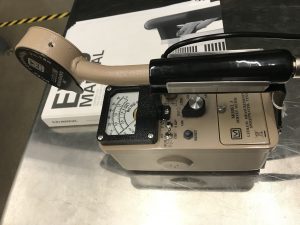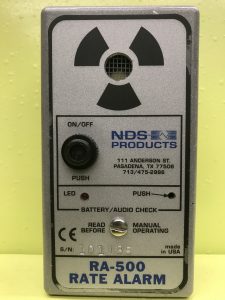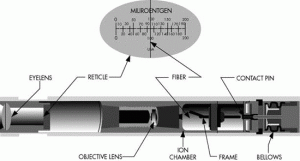Monitoring and Detection Devices
In the spirit of ALARA the field of radiography has developed safety protocols that have evolved over the years, and as the safety standards have improved the devices and tools used for monitoring radiation emission and dosage to personnel has progressed as well. In this final section, we will look at the required detection instruments required for a radiographer including the regulations associated with the operation and calibration of these devices. The following is a list of the detection instruments for radiographers:
- Survey Meters
- Area rate Alarm
- Pocket Dosimeter
- Film Badge – either a TLD (Thermoluminescent Dosimeter) or an OSL (Optically Stimulated Luminescent Dosimeter)
The Survey Meter is probably the radiographer’s most important safety tool. When surveying the vast number of industrial radiation over-exposure incidents, many of them occurred because a radiographer did not use his or her survey meter or the survey meter was not calibrated and functioning properly. NRC requires that all survey meters be calibrated by a certified calibration agency every 6 months. This is the best insurance a radiographer has to protect against radiation over-exposure incidents.

The two types of Survey Meters used in industry are the ion chamber and the Geiger-Muller (Geiger Counter).
The Ion Chamber uses an electric field (battery operated) which is applied across a volume of gas, between two electrodes. The ion chamber is capable of measuring all forms of ionizing radiation (x-ray, gamma, alpha, and beta particles) and is considered more reliable with X-ray.
The Geiger Muller (Geiger Counter) uses a gas-filled tube (cathode) surrounding a central electrode (anode) made of a fine tungsten wire. The counter detects individual particles or ions, however, too many ions will saturate the counter and it will lose accuracy. Although more sensitive than an ion chamber survey meter – Geiger counters are typically used to detect low to medium levels of radiation, but will lose accuracy measuring higher levels. For this reason, most industrial radiographers use the ion chamber survey meter.
Area Rate Alarms are just that – an alarm that sounds when the pre-set exposure rate is exceeded. The NRC requires that rate alarms be pre-set to 500 mR/hr, must be calibrated and tested annually and be +/- 20% of the true radiation dose rate to be considered calibrated and acceptable.

Pocket Dosimeters provide immediate indication of accumulated dose and have a 0-200 mR range value required by NRC. Dosimeters must be calibrated (zeroed) at the beginning of each shift. A pocket dosimeter serves a similar purpose to the radiographer’s film badge except a film badge records the dosage over a longer period (quarterly or annually). Radiographers can look at the dosimeter throughout the day, monitoring the dose they receive, further protecting themselves from over-exposure. Below is a cutaway view of a traditional dosimeter. There are also more user-friendly electronic dosimeters with digital readouts and built in alarms.

The final monitoring device is the radiographer’s personal dosimetry, typically referred to as a “Film Badge”. The purpose of the film badge is to keep a detailed record of quarterly, annual, and lifetime radiation doses received by the radiographer. In our educational setting, the film badges are sent in to a private monitoring company annually. The company reports to the radiography instructors, the RSO, and to the NRC. A few do’s and don’ts with personal dosimetry:
- Always wear at work
- Do not wear away from work (home, lunch, parts store run)
- Do not wear when receiving a medical X-ray, MRI, CT scan, etc…
- Wear dosimetry badge outside of lead aprons
“Film badge” is a term we use almost generically, but is not the same as a TLD or OSLD. Film badges contain an actual film that is “exposed” and we read the exposure like we might read a radiograph that’s been exposed. After use, the film is removed from a packet that protects it from light exposure and developed to measure exposure. The film badge is used to measure and record radiation exposure due to gamma rays, X-rays and beta particles. (Wikipedia)
A TLD, or thermoluminescent dosimeter is not actually a film badge but is worn like one and serves the same purpose of storing an individual’s radiation dose over a period of months or even a year. TLD’s can be re-set and reused.
An Optically stimulated luminescence Dosimeter (OSLD) is a device that operates on the process in which a pre-irradiated (exposed to ionizing radiation) material when subjected to an appropriate optical stimulation, emits a light signal proportional to the absorbed dose. The wavelength of the emitted light is the characteristic of the OSL material (Wikipedia)

